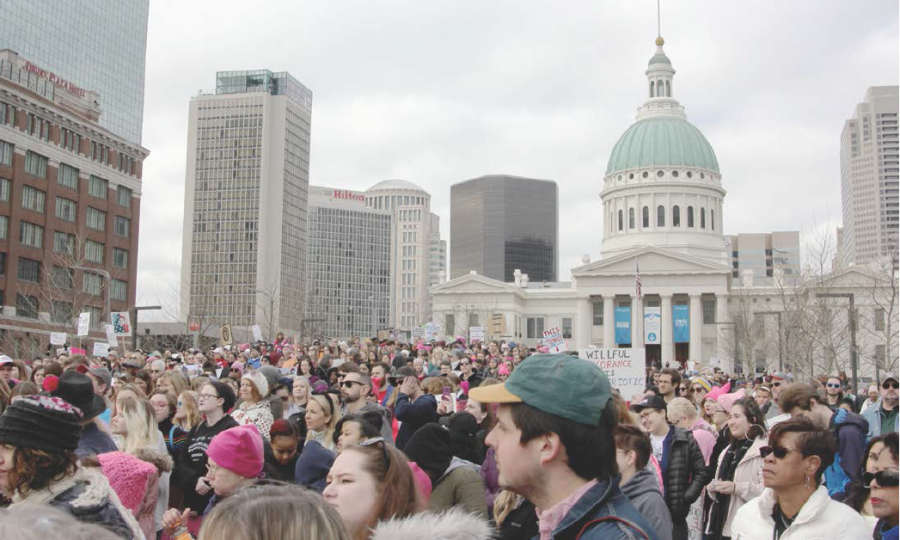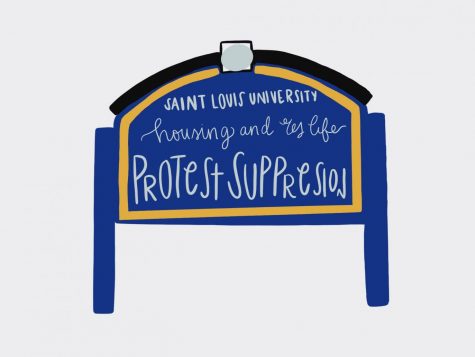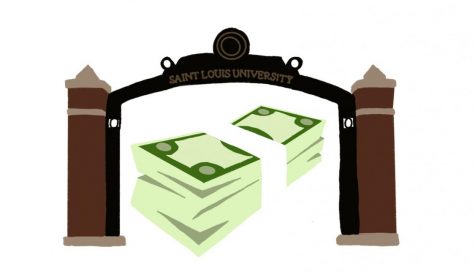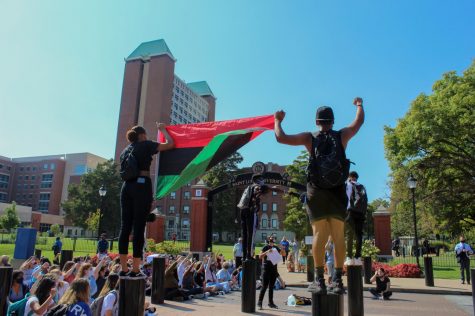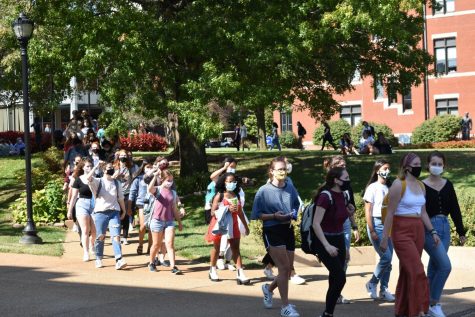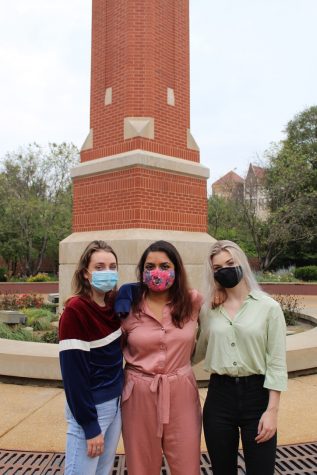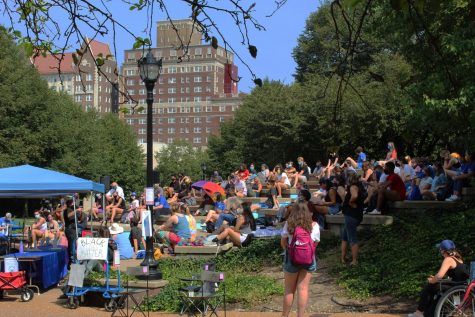The Making of a Movement: Second Annual St. Louis Women’s March
The second annual Women’s March in St. Louis drew large crowds, including many SLU students.
Listening to speakers, women and their allies stand in solidarity. The St. Louis Women’s March began at 10 a.m. and drew a sizeable crowd of people with varying colors, ideologies and backgrounds. They listened together. They marched together. They continue to look to a better future together.
On January 20, thousands of people participated in the second annual Women’s March in St. Louis. The March was held a year after the first Women’s March on Washington D.C., took place last year after the inauguration of President Donald Trump. Marches were held in numerous cities across the United States, including Los Angeles, Chicago, D.C. and here in St. Louis.
The March in St. Louis began at the Union Station hotel and participants marched down Market Street from there to the Old Courthouse and Arch grounds. The march itself lasted around two hours with speakers and events held during and after the march.
Thousands of supporters showed up for the march, bringing with them passion, spirit, anger, and lots of creatively decorated signs with powerful messages. During the event, marchers would often break into song or chant, amplifying their messages with thousands of voices. Many of the signs and chants voiced their displeasure with the current presidential administration and with the way women are treated in society, while empowering quotes and song lyrics were written on others. The march was especially prominent this year with the recent #MeToo movement gaining traction in the last year and having incredible relevance and far-reaching impact in today’s culture. Many supporters held signs or painted their faces with the slogan. The crowd was a diverse one, with people of all ages, races, genders and sexual orientations turning up to show their support.
SLU student Annie Bryan attended the Women’s March this year and the year before, and said she noticed that this year’s march was a little more inclusive.
“I went to the march last year, and this year I noticed that a lot of voices were shared that weren’t allowed to last year especially on race and how it relates [to women’s issues].,” said Bryan. “ “I was also told that this year the march was mostly organized by women of color.” The march itself was full of powerful moments, such as when a lady dressed up as women’s rights activist Elizabeth Cady Stanton posed for pictures and educated little kids about the history of the movement, and when walking down Market Street, the marchers waved to a group of little girls standing in the window of a building overlooking the march.
Gracie Simon, a SLU freshman, attended this year’s march in St. Louis after attending the first Women’s March in Washington D.C. last year. She said she was moved by how she has seen the cause move forward and the number of people showing their support.
“It makes me cry. I just tear up. It’s really awesome seeing all these men and women and their kids,” said Simon. “I think we’re moving forward. I saw so many girls I knew who were more on the conservative spectrum marching this year.”
During and after the march, local, state and national activists and public officials spoke to the crowd throughout the day. Speakers included St. Louis City Treasurer Tishaura Jones, Missouri Sens. Jill Schupp, Jamilah Nasheed, and Maria Chapelle-Nadal, and congressional candidate Cori Bush, among countless other prominent women in the community. The speakers were set up at the Old Courthouse and underneath the Arch, rallying the supporters and discussing important topics in women’s rights.
The march was a prominent event among SLU students, with numerous groups from the school showing up to the march to walk and show their support together. One of the largest groups from SLU was made up of members of the SLU College Democrats and HerCampus who banded together to attend the march. HerCampus is a newer organization made up of SLU students with mindsets for social justice. The members run a website where news articles are shared with the campus community. The joint group had between 40 and 70 people attend the march.
President of HerCampus Bryan said that when College Democrats asked to join forces, they jumped at the chance. She said that having a group of SLU students there walking together made the experience even more powerful and was a great opportunity for those “taking their first steps into activism.”
Robert Lasky, president of SLU College Democrats, said, “Reaching out to HCSLU was a bit of an impromptu idea. Supporting women is obviously a goal of both our organizations, and I think this offered a lot of students who might have been afraid to go alone a community to walk with, and that’s what this was about: supporting our amazing community of strong women at SLU, around St. Louis, and across the globe.”
College Democrats PR chair Claire Cunningham agreed, saying, “We could not have picked better marching partners.”
SLU student Jake Shaw also marched on Saturday with a group of SLU students. He said that he was marching because he was tired of seeing the way women were treated and wanted others to recognize the role that men play in gender inequality.
“I went out to the march, because I’m sick of witnessing women under assault, especially within these past couple years. I never want to come off as someone speaking in place of women, but I think it’s important for men to recognize how being male has contributed to this inequality between genders,” said Shaw.
The march this year focused on the polls and getting people to vote in the upcoming elections. The movement hopes to enact change for the cause by voting in record numbers and turning up to elect who they believe will be better leaders into the local, state and federal government in 2018. Organizers and marchers alike hope that the spirit of the march doesn’t die now that the event itself has passed.
Cunningham said, “I hope people walked away from the Women’s March understanding that marching is only the beginning. The march is nothing without registering to vote, without calling our representatives, and without understanding what’s going on at home.”
“In a way, it’s sad that we have to have a march,” said Simon. “You get a lot out of it, you feel empowered. I hope one day we won’t have to gather to prove a point that is a given right.”
When asked why they marched, everyone had different answers. But all had the same sentiment. Women are not treated equally or with the respect that they deserve, and the time has come for a change.
“Women and girls across the globe are continually having their fundamental rights revoked and limited. In Africa, girls can’t access education. In Afghanistan, women are systemically discouraged from running for public office. This isn’t an American political stunt; rather, it is a global humanitarian crisis,” said Shaw. “I encourage people to research what the march actually means and realize that it is on all of us to fight for a fairer and more equal future for all.”
Cunningham agreed, saying “Anyone who marched this weekend is a patriot; we are demanding a higher quality of this country, a quality we are fully capable of achieving.”
Your donation will support the student journalists of Saint Louis University. Your contribution will help us cover our annual website hosting costs.


